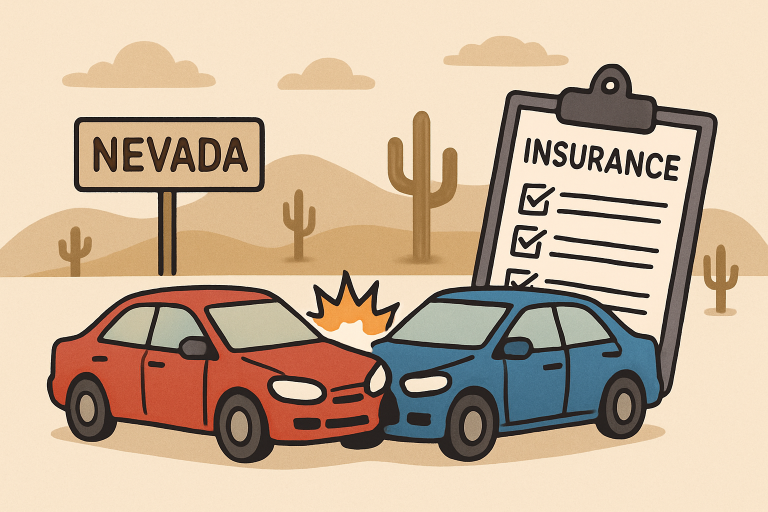Car Accidents Law
How Insurance Companies Handle Nevada Car Accident Claims
Key Takeaways
- Nevada operates under an “at-fault” system, so the driver responsible for the crash is legally liable for damages.
- Insurance adjusters determine compensation and will aim to minimize the payout for their company.
- Comparative negligence means your compensation can be reduced by your share of fault.
- Awareness of insurer tactics—such as quick settlements or delays—can help you get fair compensation.
Table of Contents
- Introduction
- Nevada’s At-Fault System Explained
- The Role of Insurance Adjusters
- Understanding Comparative Negligence Law
- Common Tactics Used by Insurance Companies
- Steps to File a Car Accident Claim in Nevada
- The Importance of Legal Representation
- Conclusion
Car accidents are stressful events, and navigating the aftermath in Nevada requires an understanding of both legal rules and the inner workings of insurance companies. If you’re involved in a collision, how your claim is managed will shape the compensation you recover for medical bills, lost wages, and other damages. This guide breaks down important procedures, legal frameworks, and insurer strategies, giving you the tools and knowledge to effectively advocate for yourself after a crash. If you need professional legal support, consider reaching out to Friedman Car Accident Lawyers in Las Vegas, a trusted firm experienced in handling accident claims. Nevada’s unique laws and insurance adjusters have a significant impact on the claims process. Understanding these laws and industry practices is crucial for accident victims, as it ensures successful settlements and financial protection.
Nevada’s At-Fault System Explained
Nevada’s car accident laws are based on an “at-fault” model, meaning that the individual determined to have caused the accident is held responsible for compensating the involved parties for their losses. This system allows victims to pursue claims directly against the negligent driver’s insurance for both property damage and personal injuries. After a crash, quickly gathering evidence—such as photos, statements, and police reports—can be pivotal in establishing liability and supporting a successful claim. Because insurance companies base their settlement offers on the evidence provided, ensuring thorough documentation from the start can protect your interests throughout the process. Learn more about at-fault systems and their impact on drivers at NOLO’s guide to car accident settlements and car insurance.
The Role of Insurance Adjusters
Once a claim is filed, it is assigned to an insurance adjuster, who is responsible for reviewing the case and determining its merits. Adjusters investigate the accident, analyze all submitted evidence, review medical documents, and estimate the amount of loss or damage. While adjusters may present themselves as neutral parties, it’s important to understand that they are employed by insurance companies and are incentivized to save their organization money. Their goal is to settle the claim quickly and for the lowest possible amount. When speaking with adjusters, always provide factual details without admitting fault, as even casual language or a simple error in recounting the accident can be used against you in the final assessment of your claim.
Understanding Comparative Negligence Law
One of the defining features of Nevada’s legal framework is its comparative negligence law. If you are partly responsible for the accident, you may still recover damages. However, your award will be reduced proportionally to your degree of fault. For example, if you are assigned 30% of the blame and your damages total $15,000, you would only receive $10,500. Importantly, if you’re more than 50% at fault, you’re barred from any compensation. This percentage-based system makes the precise evaluation of fault critical and is another reason to seek legal counsel when disputes arise regarding blame or the size of settlement offers.
Common Tactics Used by Insurance Companies
Insurance companies deploy various tactics to minimize their payouts. Common strategies include:
- Issuing early, lowball settlement offers before the extent of injuries is clear.
- Requesting recorded statements in hopes of catching inconsistencies or admissions of fault.
- Prolonging the claims process to pressure claimants into accepting a smaller settlement due to financial strain.
Awareness of these tactics helps you avoid being taken advantage of during a vulnerable time. Do not agree to a settlement or provide extensive statements until you have fully assessed your injuries and considered professional advice.
Steps to File a Car Accident Claim in Nevada
- Report the Accident: Contact local law enforcement immediately following the accident, even if it seems minor. A police report provides essential third-party documentation.
- Gather Evidence: Collect photographic evidence of vehicle damage, injuries, and road conditions. Take down witness statements and the other driver’s details.
- Notify Your Insurance Company: Inform your insurance provider promptly, supplying all necessary documentation and evidence.
- Consult a Legal Professional: Engaging an experienced attorney can help you navigate complex claims, avoid mistakes, and understand the true value of your case.
The Importance of Legal Representation
Car accident victims may feel overwhelmed, particularly when navigating aggressive insurance tactics and unfamiliar legal terminology. An attorney levels the playing field by advocating for your rights, handling negotiations, and ensuring that all paperwork and evidence are in order. They can also take your case to court if settlement negotiations fall through, maximizing your chances of full and fair compensation.
Conclusion
Understanding Nevada’s insurance claim process enables you to act quickly, avoid common pitfalls, and negotiate confidently. With solid knowledge of the at-fault system, comparative negligence rules, the function of insurance adjusters, and awareness of standard insurance company tactics, you’ll be empowered to protect your interests. Take action after an accident: gather evidence, seek timely support, and consider legal guidance to secure the outcome you deserve.






